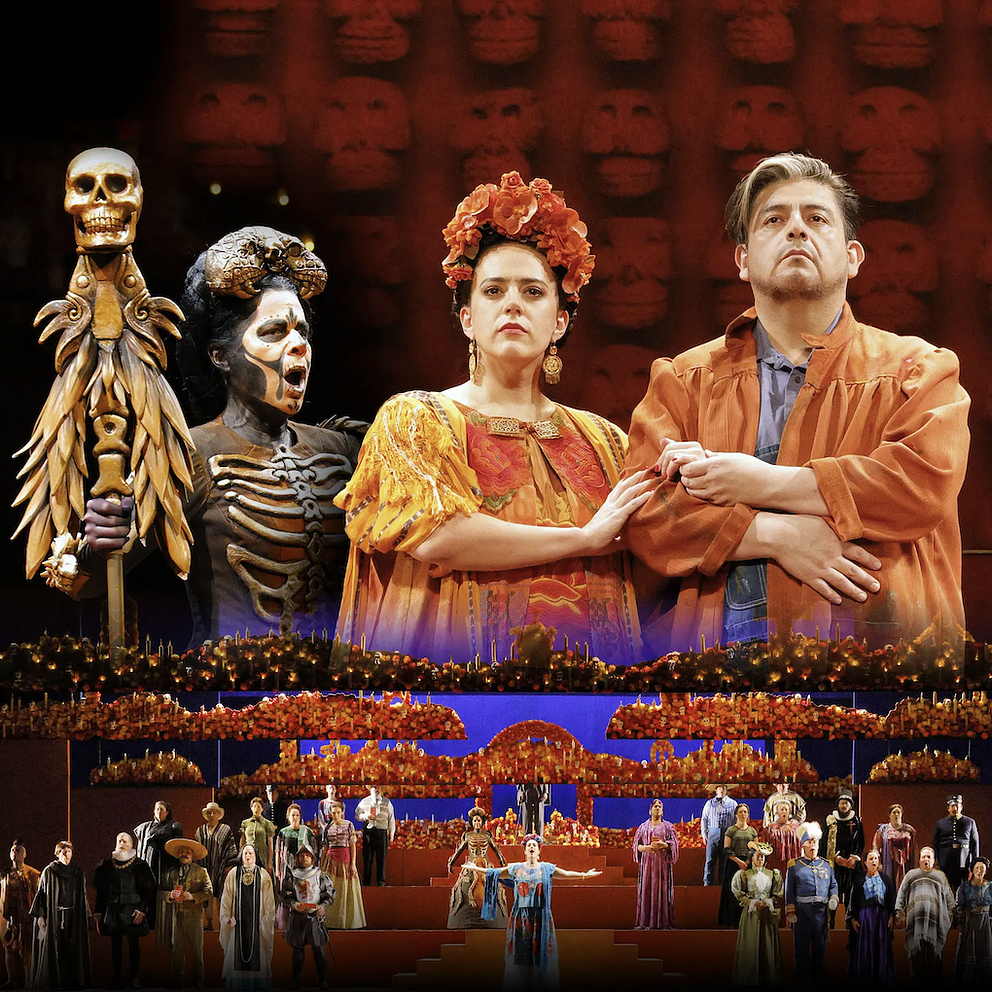EL ÙLTIMO SUEÑO DE FRIDA Y DIEGO
Los Angeles Opera
Los Angeles
Through Dec. 9, 2023
“Ah, a night at the opera! El último sueño de Frida y Diego! How absolutely marvelous!” So went my internal dialogue — played out in my best Anna Karenina–era Greta Garbo accent — as I sashayed into my Uber Saturday night. “Why, I say, darling, no one but a tourist or a copper parks downtown, everybody knows that!”
Before Frida y Diego, I had never been to the Los Angeles Opera. Running late, but fashionably so, I twirled through the Dorothy Chandler Pavilion, passed the stunning orange blossom Frida Kahlo – themed photo-op/vigil, ascended the grand staircase, slugged a $20 glass of red (lesson learned: you can’t take alcohol in with you), and ran happily to my seat. And what a seat it was: row 21, seat B2, balcony wing, stage left. I settled into golden velour as composer Lina González-Granados took her place behind the podium.
The story of Frida y Diego takes us to hell and back, literally. On el Día de los Muertos, Diego Rivera, Frida’s tempestuous husband — a renowned painter — calls her back from the underworld. Frida, who previously promised never to return to the land of the living, resists his call until the Keeper of Souls (the classic Catrina, or Mexican dandy) summons her to help Diego die. Frida resists until another soul, Leonardo, in drag as a very-much still-living Garbo, reminds her that if she returns to Earth, she can paint again.
Garbo’s got a point. Frida makes a Little Mermaid–esque deal with Catrina: she’ll return to Earth for 24 hours to help Diego. If she touches him, though, she’ll remember the agony whose end she welcomed in death.
Was an accursed lover coming back from the dead a standard opera story? Beats me. But what I lacked in critical knowledge of librettos, I made up for in Frida-lore. And from what I know of the painter, it was no surprise that costume designer Eloise Kazan’s work sang. The characters of the underworld gleamed in shades of persimmon with historically accurate ensembles dating back to Tenochtitlan. Such glory was framed exquisitely by the triumphant, three-tiered scenic design of Jorge Ballina.
For all its glitz and glam, this opera is no Funko Pop Frida. Thankfully, the work shies away from the consumerist idealization of the artist popularized in the last 10 years—this is communist, feminist Frida. Even if Diego’s character is a little one-note, writer Gabriela Lena Frank takes pains to draw on Frida’s life and work to create beautiful verse. Particularly poignant is Diego and Frida’s discussion of their shared dream of political freedom in Mexico: “Tenochtitlan, my ancient Mexico, be once again the land of the sun.” A large portion of the cast and creative team are Latin American; subtitles flash above the stage in both Spanish and English.
Suffice it to say that, from where I sat prettily, the whole evening was divine, darling — absolutely delicious! A little context: I did not pay for my golden ticket. My boyfriend’s mother works in the costumes department. (Good on the Opera for the quality of the free-for-employees comps.) But as I walked out, into the first, cold rain of the season, the Greta Garbo voice inside my head asked me if I thought Frida would have liked the show. An unhoused man walked by me then, wearing a teal blanket over his head, the exact shade of Frida’s shawl in the opera. Her most truthful line rang in my ears: “The poor are as invisible as the dead.” Like all art, for the opera too, the content does not escape the context. I watched as the man, one of so many homeless downtown, crossed the street. The playbill I held over my head began to disintegrate in my hands from the wet. Probably not, darling.






